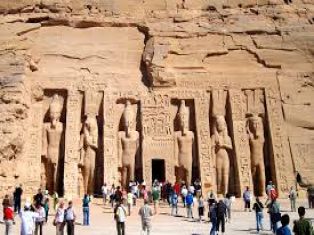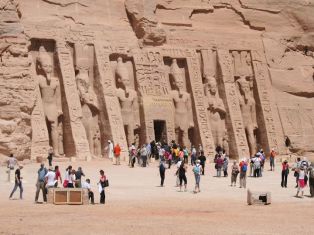Karnak Temples
Introduction:-
The temples of Egypt are without doubt among the most impressive monuments to have survived from the ancient world, many of these structures still rank among the greatest architectural accomplishments of human history, hundreds of temples built throughout Egyptian history including many of which we doubtless have no record, they offer a unique view into the lives and minds of the ancient Egyptians, some temples served primarily as houses of the gods, built and expanded over the millennia to serve their deities, while others were mortuary monuments built to serve the spirit of deceased kings and to ensure their comfort and rule in the hereafter, still other temples served different purposes, some doubling as fortresses, administrative centres and even as concrete expressions of propaganda or royal retreats. The great temple of Amoun at Karnak the largest religious structure the world has ever known, the largest temple complex ever built by man, it represent the combined achievement of generations of ancient builders and covers a truly massive area of about 60 acres, Karnak requires half a day just to walk around it. Karnak consider to be the great national monument which has no equal, it’s not a single temple but a construction within another, and a shrine within a shrine, almost all pharaohs in particular those of the new kingdom wished to record their names and deeds for posterity, most of the structure was built in honour of Amoun-Ra, his consort Mout and his son Khonso had their own shrines, within the complex which is dedicated to other gods, like Montu, Ptah and Hathor. Karnak temples are considered to be a history book stating the history of Egypt from the middle kingdom to the Ptolemaic period, Karnak was known as ipet –isut “the most select of places “ , and during the Ptolemaic time it was known as pt hr s3 t3 “ the sky above the earth “ . The modern name Karnak has 3 theories adopted to it: 1- The scholar Bergait said it is an arabic word which is no longer used in Upper Egypt, but it still in use in Sudan, and means the protected village. 2- Dr. Ahmed Badawy said that: the word corrupted from the word khawarnak which was a place in Iraq. 3- Dr. Ahmed Fakhry said that: it is drived from a village nearby the temple which still has the same name.
The outer open courtyard:-
Consists of:-
1- The harbor: located in front of the temple and it has a rectangular shape built with blocks of stone, and it was built for the boats of Amoun-Raa when it used to sail from the temple for different feasts, the harbor was used till the 26th dynasty. 2- The obelisks: there were 2 obelisks standing just before the sphinx avenue, one of each side, one of them remains now and its 2 meters high, made of red sandstone dating to king Seti II. 3- The sphinx avenue: a slopping path leading to the sphinx avenue which is before the 1st pylon, their rams heads symbolizing the god Amoun and each holding a statue of the king between its lions paws, the sphinxes have the name of Ramses II; there are already 20n sphinxes on each side of this outer court.
**The 1st pylon:- **
It is an unfinished pylon dating to the 22nd dynasty – 30th dynasties, every wing of this pylon has 4 recesses and 4 windows for the flags of the temple, there is as well some graffiti on this pylon dating back to the time of napoleon. Behind this pylon to the rear on the southern side, there is a huge mud-brick ramp which was used in its building process.
The 1st open court:-
It has a lot of names like the front court or the festivals hall, consists of several buildings: 1- The triple shrines of king Seti II Located to the left side of the open court, dedicated to the god Amoun-Raa, his consort Mout and their son Khonso, the majority of the scenes representing religious activities by king Seti II with various gods. a- The middle shrine which was dedicated to the god Amoun-Raa, while on the sides of its entrance we could see the names of king Seti II, the scenes on the walls of the shrine showing the king burning incense before the sacred boat of Amoun-Raa, the rear wall has 3 niches to house the statues of the gods . b- The shrine to the left of Amoun’s shrine is belonging to his consort Mout, the western side of the entrance has no reliefs at all, while the eastern side has a representations of king Seti II offerings to Amoun & Mout, the rear wall also has a niche for the statue of the goddess . c- The shrine to the right of Amoun’s shrine is belonging to the son Khonso, were on both sides of the entrance Seti II is shown offering flowers to the gods, the western wall is shown Seti II burning incense and pours water to the sacred boat of Khonso, and in front of the boat are 2 obelisk carved which may have been originally built in front of the shrines.
**The temple of Ramses III:- **
It is situated to the right hand side of the open court, an excellent example of the new kingdom cult temples. It was dedicated to the god Amoun in the 2 forms in which he appears most frequently Amoun-Raa king of the gods and lord of Karnak, and Amoun-Raa kamutef he who is before his harim, it’s not certain when it was built but it must have been between years 11 – 22 of the kings reign, when it was built it stood isolated in front of the pylon, was known as the house of Ramses ruler of Heliopolis in the house of Amoun. It consists like other state temples of a pylon shows the king Ramses smiting his enemies before the god Amoun-Raa who is giving him a dagger, flanked each side by a colossus of the king, a court decorated by 8 square pillars with osiride figures of the king, leading to a portico with 4 columns, a hypostyle hall, and a series of sanctuaries dedicated to the triad of Thebes (Amoun-Raa, Mout and Khonso). The deeply incised relief work of the figures & inscriptions in the temple still shows traces of colour, but the workmanship is inferior to that of Medinat Habu built by the same king.
Taharka’s court:-
In the middle of the open court are the remains of the gigantic kiosk of Taharka (25th dynasty) originally consisting of 10 huge papyrus columns, all are in ruins except only one remains now after being restored by the department of antiquities in 1929, it is 21 mts high, has inscriptions carrying the names of Pasmatic II (26th dynasty) and Ptolemy II, and in the middle of this court is a pedestal (alabaster) which was done for the sacred barque of Amoun-Raa.
- Also in the open court there is a statue which was called by the Egyptologists the unknown pharaoh, probably belongs to Ramses II and was seized by Pa-Nedjem and Ramses IIII, this statue was buried under the ground till it was found at the early 1950s. It is representing Ramses II with crossed arms holding the famous crook & flail and wearing the double crown of Egypt, and between his legs a statue of his daughter benta-anta. On both sides of the entrance of the 2nd pylon, there were 2 statues of Ramses II only one of them remains.
**2nd pylon:- **
The building was begun in the time of king Hor-Moheb but not completed until the reign of king Ramses I, as well as the names of Ramses II which is inscribed there, however the entrance of the pylon was decorated and painted by Ptolemy II and the cartouche of Pasmatic II was recorded as well (26th dynasty).
**The hypostyle hall:- **
It was erected by king Seti I with additional decoration by Ramses II, it is called the temple of Seti is glorious in the domain of Amoun, in total the area covered is 6000 sq.m, its large enough contain both St.Peters church in Rome and St.Pauls cathedral in London.
The hall contains 134 columns which are of 2 different capitals and 2 different heights as well, the 12 columns flanking the processional way higher to accommodate clerestory windows.
The sandstone slabs which roofed the hall have been dislodged by earthquakes, the remaining 122 columns have papyrus bud capitals and are set each side in 9 rows of 7 columns each, they provided a forest of columns intentionally representing it seems a papyrus marsh, there is quite a lot of colour still left on the upper part of the columns and on the roof slabs still in position.
The north side of the hall was decorated by Seti I, and the south side by Ramses I.
Most of the scenes in this hall show offering scenes from Seti I and Ramses II to the god Amoun-Raa and his older consort Amounet and different deities.
The 3rd pylon:-
It was built by Amenophis III who used blocks of stones from different buildings of the temple, this pylon was restored in 1930, and during the restoration they found the chapel of Snwsrt I, the shrine of queen Hatshepsut and the alabaster chapel of Amenophis I as well, have all been moved to the open museum of Karnak temples.
**The 4th pylon:- **
It is badly damaged, it was built by Tuthmosis I and it was the façade of the temple during the 18th dynasty until the reign of Amenophis III. During that time there were originally 6 obelisks standing 2 for king Tuthmosis I 2 for king Tuthmosis III 2 for king Amenophis II Nowadays there is just 1 obelisk remaining in the site belonging to Tuthmosis I, and it is 19 mts high and 130 tons in weight; however the rest of the obelisks were transferred to different places.
recommended tours

Private Half - Day Tour: Philae Temple - Unfinished Obelisk & High Dam



